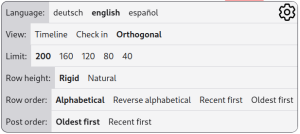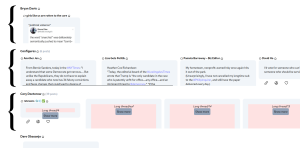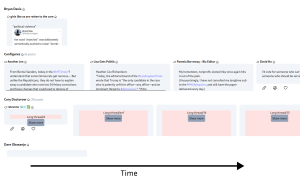Mastodon normalizer
Project link (demo):
https://normalizer.webflux.us/
Source code:
https://gitlab.com/adamwight/mastodon-normalizer
Problem statement: Social media amplifies the loudest voices more than is necessary. In real life, we know that a person who speaks often and loudly might be full of good insights, or they might just suffer from an excess of hot air. Either way, we aren't obliged to give this person all of our attention just because they're loud.
There is rarely any way to deal with this, no alternative between full volume and blocked, to allow us to better hear the quieter voices.
Experimenting with normalization

When @futurebird@sauropods.win mentioned the fun idea of a customizable timeline allowing us to check in on our friends' latest posts, I was excited to see how it might be applied. I'm happy with the results so far! You can login to the demo service using your own Mastodon account and instance, or try out the guided tour as a guest. Preferences currently look this this.

The default view is called the "orthogonal" view, which gives each author equal vertical space in your timeline regardless of how many posts they write or how big their attachments.
A more extreme version of this view is the "Check in" mode which shows only one post from each account. This can be seen as a normalization of both vertical and horizontal space.

Clicking on a row of posts will expand and focus. To expand all posts by default, choose the "natural" row height preference.
Time dimension

If we reintroduce the timeline but with its axis tipped by 90 degrees, we can list all of each author's posts as an isolated strip running from left to right.
Development
So far, this software is the labor of one unpaid person acting on friendly suggestions. Contributions, suggestions or other resources are welcome!
Its architecture is a server-side, Elixir Phoenix Live View application which updates the user's browser by sending HTML over a websocket. It's authenticated temporarily to act as the user. Posts and tokens are kept in server memory and kept as state for the session, then forgotten on close.
In the long term, user algorithms will ideally be visually- and script-programmable, and shareable.
Resources
Get involved
- Try out the demo site.
- Read and install the source code.
- Write to @a@social.wikimedia.de
Similar projects
- Ebou by Benedikt Terhechte (source code) (highlighted by @h_albermann) shows a timeline with a single card for each user, and clicking on a user expands their timeline into a new column. Looks very active as of August 2023.
- Bluesky's "marketplace of algorithms".
Reporting related to the topic
- Young, Nora (2023-09-08). "As EU law hopes to rein in Big Tech's algorithms, this reporter wants a 'third path'". Spark. Retrieved 2023-09-11.

